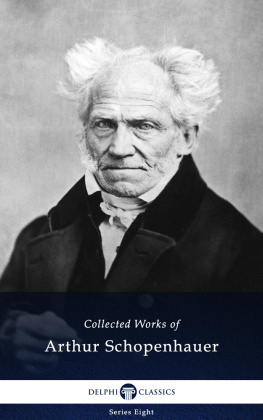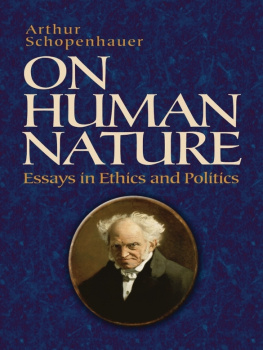
Schopenhauer: A Very Short Introduction



Christopher Janaway
SCHOPENHAUER
A Very Short Introduction





Contents
Preface
This book aims to give a sympathetic but critical account of Schopenhauer's philosophy. He constructed a system which embraces metaphysics, epistemology, philosophy of mind, aesthetics, ethics, and the meaning of life. But as a complete system his philosophy has had few adherents, and he never founded a school of thought. His influence on the history of thought was rather that of provoking and inspiring generations of artists and thinkers from Wagner through to Wittgenstein. Some of his ideas prefigure those of Freud, and his most important philosophical impact was on Nietzsche, who at first found his pessimist conclusions attractive and later regarded them as repulsive, but was always in close dialogue with his 'great teacher'. Schopenhauer was a true atheist, who fundamentally questioned the value of human existence. Existence for Schopenhauer is a purposeless, painful striving, driven by an unconscious force that we cannot control. Release from this existence comes from losing one's individuality in aesthetic experience, in compassion for the world, and in self-denial. While examining all the main aspects of Schopenhauer's philosophical system, this book hopes to bring out the challenging nature of the questions he asks about human existence.
c.1.
August 2001
Abbreviations and works cited
Schopenhauer's works are referred to as follows, in translations by E. F. J. Payne, unless otherwise stated. Some very minor changes are made to some quoted passages.







List of illustrations
1 Schopenhauer: daguerreotype, 4 June 1853 xv Schopenhauer-Archiv, Stadt- and Universitatsbibliothek, Frankfurt am Main
2 Schopenhauer as a youth, 1802 7 Reproduced from Arthur Hubscher. Schopenhouer-Bildnisse (Frankfurt am Main: Waldemar Kramer, 1968)
3 Schopenhauer: miniature portrait by Karl Ludwig Kaaz,18og 11 Schopenhauer-Archiv. Stadt- and Universitatsbibliothek, Frankfurt am Main
4 Schopenhauer: photograph by Johann Schafer, April 1859 13 Hulton Archive
5 Schopenhauer: portrait by Ludwig Sigismund Ruhl, around 1818 23 Schopenhauer-Archiv, Stadt- and Universitatsbibliothek, Frankfurt am Main
6 Title page of The World as Will and Representation 1859 38 Schopenhauer-Archiv, Stadt- and Universitatsbibliothek. Frankfurt am Main
7 Manuscript extract from the second volume of The World as Will and Representation 56 Schopenhauer-Archiv. Stadt- and Universitatsbibliothek, Frankfurt am Main
8 Schopenhauer: Hamel portrait by Julius Hamel, 1856 72 Schopenhauer-Archiv, Stadt- and Universititsbibliothek. Frankfurt am Main
g Schopenhauer's flutes among other objects in the Schopenhauer-Archiv, Frankfurt am Main 86 Schopenhauer-Archiv, Stadt- and Universitatsbibliothek, Frankfurt am Main
1o Title page of The Two Fundamental Problems of Ethics 1841 91 Schopenhauer-Archiv, Stadt- and Universitatsbibliothek. Frankfurt am Main

1. Schopenhauer: daguerreotype, 4 June 1853
Chapter 1
Schopenhauer's life
and works
Arthur Schopenhauer was born in 1788 in Danzig, and died in Frankfurt am Main in 186o. There are a number of photographs taken during the last decade of his life, from which we derive our most immediate sense of the man. He looks unconventional and grimly determined, but the sparkle in his eye is that of someone vigilant, incisive, and capable of mischief - not altogether different from the persona which emerges from his writings. At the end of his life Schopenhauer was just beginning to enjoy a measure of fame. His philosophy, however, is not a product of old or middle age. Although most of the words which he published were written after he settled in Frankfurt at the age of 45, it was in the years between 1810 and 1818 that he had produced the entire philosophical system for which he became celebrated. As Nietzsche later wrote, we should remember that it was the creative, rebellious energy of a man in his twenties which produced The World as Will and Representation. The mature Schopenhauer occupied himself in consolidating and supplementing the position he had presented in this masterpiece, which was, until very near the end of his life, neglected by the intellectual world.
Independence of spirit is the trait most characteristic of Schopenhauer. He writes fearlessly with little respect for authority, and detests the hollow conformism which he finds in the German academic establishment. But behind this is the significant fact that he was also financially independent. When he came of age in 18og, he inherited wealth which, with astute management, was sufficient to see him through the rest of his life. His father, Heinrich Floris Schopenhauer, had been one of the wealthiest businessmen in Danzig at the time of Arthur's birth. A cosmopolitan man, committed to the liberal values of the Enlightenment and to republicanism, he left Danzig when it was annexed by Prussia, and moved to the free city of Hamburg. Arthur had in common with his father a love of French and English culture and a horror of Prussian nationalism. The name 'Arthur' was chosen because it was shared by several European languages - though the intention here was chiefly to fit the infant for his envisaged career in pan-European commerce. Later Arthur felt he had also inherited his father's intense, obsessive personality. His father's death in 1805, probably by suicide, was a great blow to him.
Next page



























